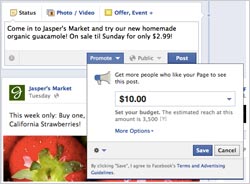Facebook Rolls Out Promoted Posts, New Page Tools
- by Mark Walsh @markfwal, May 31, 2012
 Facebook is taking steps to boost
ad spending directly through brand pages, while also giving marketers new tools for managing their presence on the social network. The social network has rolled out promoted posts to extend the reach of page content, as well as providing companies with different access levels to their Facebook
pages internally.
Facebook is taking steps to boost
ad spending directly through brand pages, while also giving marketers new tools for managing their presence on the social network. The social network has rolled out promoted posts to extend the reach of page content, as well as providing companies with different access levels to their Facebook
pages internally.
Promoted posts allow Facebook page administrators to boost exposure for their posts beyond the normal reach they get in fans’ news feeds -- and without having to go through a separate ad dashboard. Facebook, however, doesn’t specify how much larger a percentage of a brand’s fans will see a post that’s promoted.
Beth McCabe, vice president of social marketing and technology at Digitas, said the new feature is mainly a step to make advertising easier on Facebook. “Promoted Posts will likely appeal to small brands, allowing them to reach a larger audience and drive more awareness around the products and/or services they're looking to promote on the platform,” she said.
The option is available to any page with more than 400 fans and any type of post can be promoted, including status updates, photos, offers, videos and questions. The posts appear directly within desktop and mobile news feeds rather than in the right column where ads usually appear. Promoted posts are marked as “Sponsored” in the feed and go to friends of people who interact with the units as well as brand fans.
The minimum spend is $5 for reaching between 20 and 2,200, according to the blog Inside Facebook. “The cost per reached fan seems to vary by page, but Facebook would not comment on what factors may influence price,” it stated in a post on the new ad offering. In terms of campaign length, posts can be promoted for up to three days after they are originally created.
One factor underlying the drive to reach more fans is that they spend twice as much as non-fans, according to Facebook research. “Considering this is a paid offering, marketers might reserve this extra promo push for content they really want to drive more engagement and interaction for,” noted digital marketing firm Hubspot in a separate blog post on promoted posts.
Simon Mansell, CEO of social media marketing firm TBG Digital, however, suggested promoted posts could be an expensive proposition on a CPM basis, depending on how large the audience reached with a minimum $5 buy. If more and more ads start going into the news feed as a result, he also said Facebook risks a backlash from users.
Separately, Facebook has created five different levels of internal access to pages so brands can assign different roles to people involved in maintaining a company’s presence on the site. Brands, for example, can now limit access for some to creating content, others to creating ads, and still others to analyzing a page for insights. Facebook had announced it would introduce different page access levels at its fMC conference in February. Previously, each administrator would have access to all the different page operations.
In addition, Facebook will now also allow brands to schedule posts to appear at specific times directly instead of having to rely on third-party tools from companies like HootSuite or Buddy Media. A new feature allows page owners to schedule posts up to six months in advance and at 15-minute intervals.
Mansell said small- to-medium-sized companies might take advantage of the new scheduling and page access capabilities to take more Facebook marketing management in-house. But Inside Facebook suggested that social media platform managers shouldn’t be too worried.
“Most platforms offer a unified dashboard for Facebook, Twitter and other networks, so that user can create a post from one location and then schedule it to appear in several channels. This is something Facebook is not likely to replicate,” it stated in a post today.


